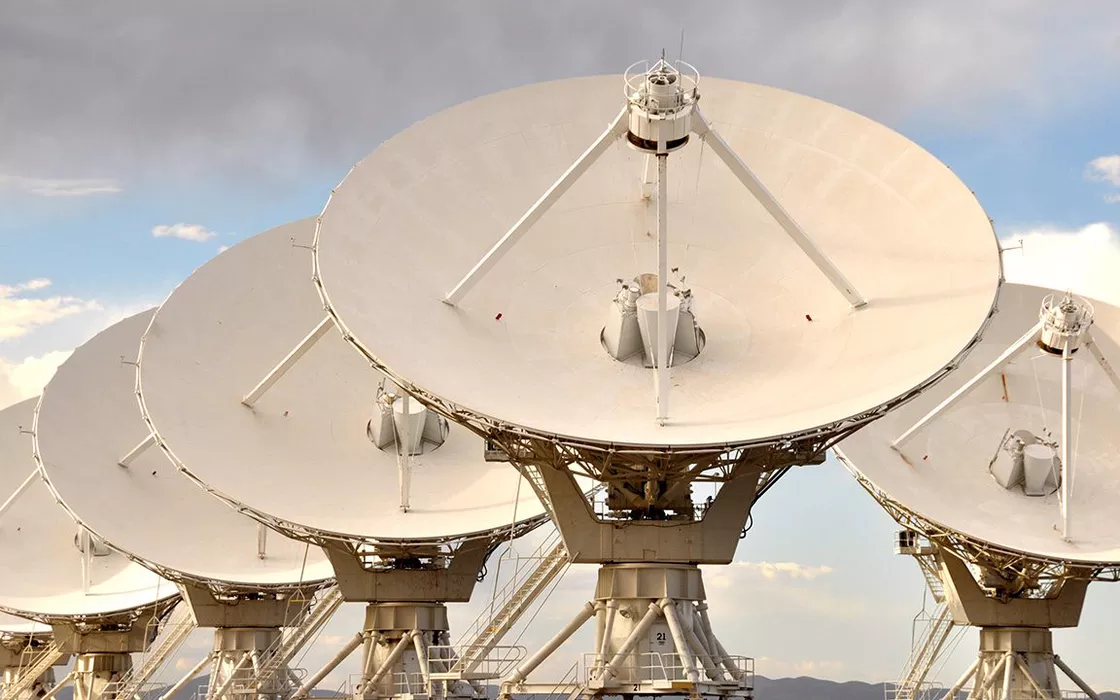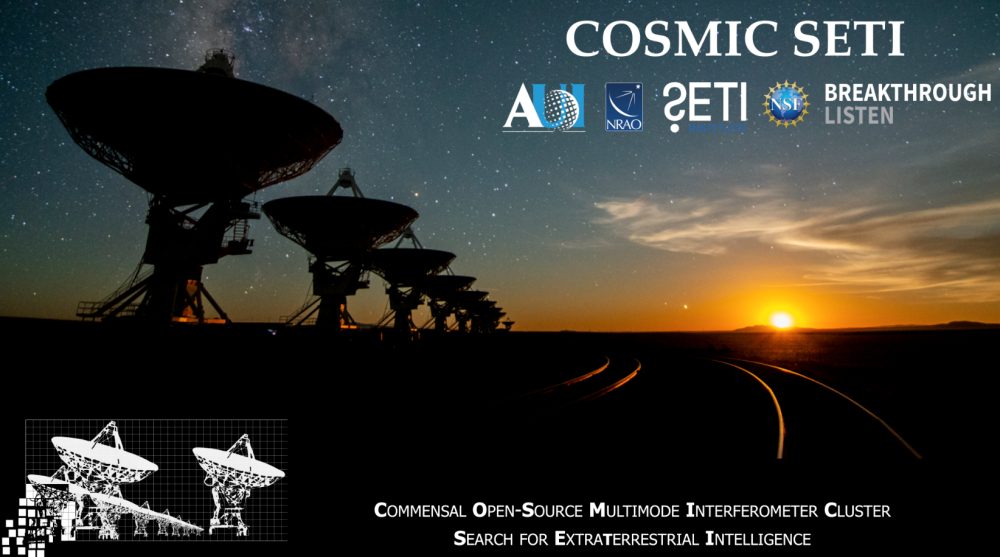Anyone who starts to have some gray hair will certainly remember the project SETI@home. This is a project that used the unused computing power of personal computers of volunteers around the world to analyze signals from space for possible signs of extraterrestrial intelligence. Born in 1999 and managed by the University of California (Berkeley), SETI@home closed its doors in March 2020 after many years of honored service. The decision is the result of the impossibility, expressed by the researchers, of managing the analysis phase of the data generated following the distributed computing.
With the recent project COSMIC (Commensal Open-Source Multimode Interferometer Cluster), however, SETI has opened a new chapter in its history, in the context of research activities for extraterrestrial civilizations. Also because, from now on, SETI can also count onartificial intelligence and on the resources available in the largest research centers to separate potentially useful information from the immense (and powerful) background noise.
Founded in 1984, SETI (Search for Extraterrestrial Intelligence) is a nonprofit research and education organization committed to the mission of leading humanity’s quest to understand the origins and spread of life and intelligence in the universe. The SETI Institute is a leading partner for industry, academia and government agencies, including NASA and National Science Foundation.
What is the VLA, advanced telescope system
Acronym for “Very Large Array“, VLA is a radio telescope system located in the USA. It is one of the most advanced systems ever and plays a significant role in astronomical observation.
VLA is made up of a set of 27 satellite dishes furniture, each of which has a diameter of 25 meters. The antennas can be moved on railway tracks along Y- or L-shaped configurations, allowing the VLA to adapt to different observation needs. The ability to configure antennas flexibly allows the VLA to achieve a very high resolution in his observations.
The telescope system is used in various application fieldsfor example the study of galaxies, stars, quasars, and other celestial phenomena that emit radio waves.
Already at the beginning of 2022, SETI had communicated its intention to use VLA to collect i data flows coming from deep space, not just from the galaxies closest to Earth. Now he steps on the accelerator.
COSMIC SETI: how the ear that listens to communications from intelligent life forms works
As several scientists have pointed out over time, it is highly unlikely that Earth’s inhabitants are the only example of intelligent life form in the entire universe. The information (partial, to put it mildly) on its structure and the data collected over many years of studies tell us that – more simply – it is in fact equally unlikely to make contact with any extraterrestrial civilization.
The difficulty for two civilizations in the universe to “meet” and communicate is often described as the “Fermi paradox“. Among the factors that limit and complicate the possibility of direct contacts there are, evidently, cosmic distances, the limit of the speed of light (it marks a point of reference for the speed with which interstellar communications can flow), the very duration of civilizations (ours is very recent if we compare it only to age of our solar system; other civilizations may have become extinct, in other places), the use of communication methods completely different from the ones we know. The Fermi paradox, however, remains a an intriguing puzzle which constitutes the pillar of all the research carried out within SETI.
Use of data from the VLA, in real time
With an announcement published in January 2024, the researchers explain that they conducted the project SETI COSMIC at an excellent level of ripeness. COSMIC leverages the VLA’s existing infrastructure to dramatically expand the scope of the search for extraterrestrial life. By using the VLA as a supporting platform, COSMIC can benefit from its advanced features detection.
Previous searches were limited to a small number of stars. Thanks to the VLA, COSMIC can now extend its search to hundreds of thousands or even millions of star systems. Suffice it to say that COSMIC now covers the80% of the entire celestial vault. Furthermore, the analysis of potential extraterrestrial signals is carried out in frequency spectrum between 0.75 and 50 GHz.
SETI researchers explain that the data is processed continuously and in real time, as it arrives from the VLA system. Thanks to this scheme it is possible to conduct a rapid and continuous analysis of even the most deboli where radiofacilitating investigations of follow-up to determine whether the detected signals may be technosignature.
Artificial intelligence to extrapolate any technological signatures
Find some technological signatures o technosignature in signals coming from deep space would mean having proven proof of the existence of an intelligent alien civilization. Even if these clues reached Earth, their extraction has so far been a complex matter. First of all because of the cosmic background noise: Radio telescopes collect a vast amount of signals from natural sources in space. This cosmic background noise is very high and makes it difficult to distinguish artificial signals from naturally generated ones. Stars, galaxies and other cosmic objects can emit radio signals that vary over time. Distinguish between “naturally occurring” and potential variations technosignaturerequires rigorous statistical analysis and careful consideration of multiple factors.
The same where radio coming from Earth, such as those from television, radio and satellite broadcasts, can generate interference in the data collected by the VLA. This interference can mask or be confused with possible extraterrestrial signals. It has already happened in the past. Think, for example, of the famous case of the “Wow!” signal. (1977).
Earth has thus far been relatively silent in terms of strong radio signals sent into space. If other extraterrestrial civilizations existed and used similar transmission technologies, they might not be easy to detect at all.
Therefore, artificial intelligence and real-time analysis in search of relevant signatures (which can then be “skimmed” by real personnel) plays and will increasingly play the lion’s share of the SETI COSMIC project.
COSMIC, on the other hand, calculate 64 synthetic beams in the celestial vault and all fall within the range of a single antenna. Every potentially interesting signal identified in each of the 64 beams is searched for in the others. When it appears in more than one, the “label” of possible alien transmission is automatically removed.
At what distance can the signals be picked up
At the time, SETI managers declared that COSMIC would be able to monitor millions of stars at distances up to 81 light years. Furthermore, it is able to detect any radio signals sent by antennas similar to that of the Arecibo radio telescope (now damaged beyond repair at the end of 2020).
It must be said that 81 light years, compared to cosmic infinity, is a bit like watching neighbors overlooking the same courtyard. If we found signs of an intelligent civilization within 81 light years it would be very fortunate and truly incredible since, in cosmic terms, we are dealing with a distance relatively next (although light, and therefore signals, take up to 81 years to arrive on Earth from the moment they are sent…).
It is not known, today, from what distances the signals that COSMIC is capable of detecting in practice can arrive. The only certain fact is that COSMIC has the sensitivity needed to recognize short radio signals, down to the order of nanoseconds. Transmit through interstellar distances is uneconomical: in terms of power, the energy resources required to maintain an omnidirectional transmission for hours, days, months or even years such that it can be detected tens or even hundreds or thousands of light years away are immense.
It would be more convenient for an alien civilization to broadcast nanosecond pulses which hit the Earth for a short period before moving to other planetary systems, and then returning to “target” our solar system.
The images in the article are taken from the article What is COSMIC? (Source: SETI).


